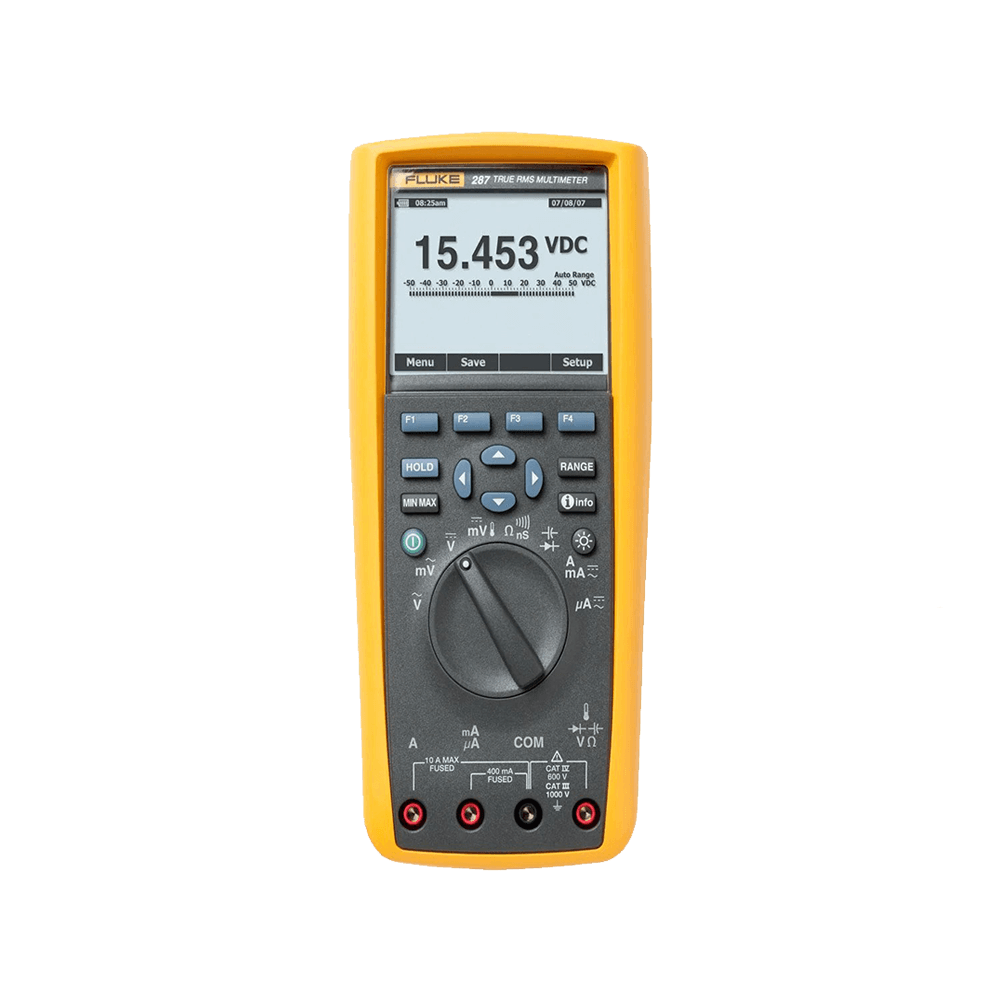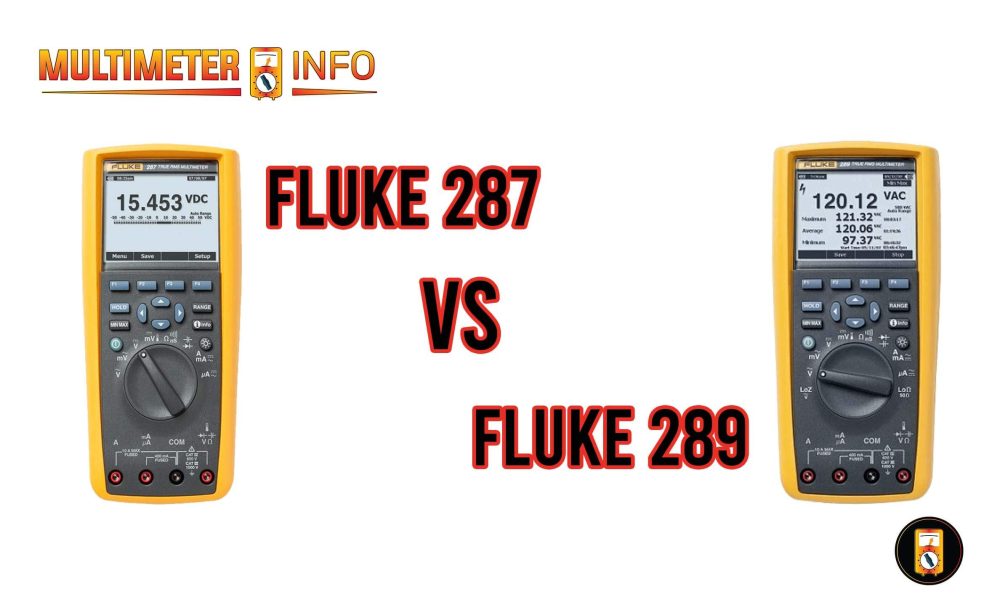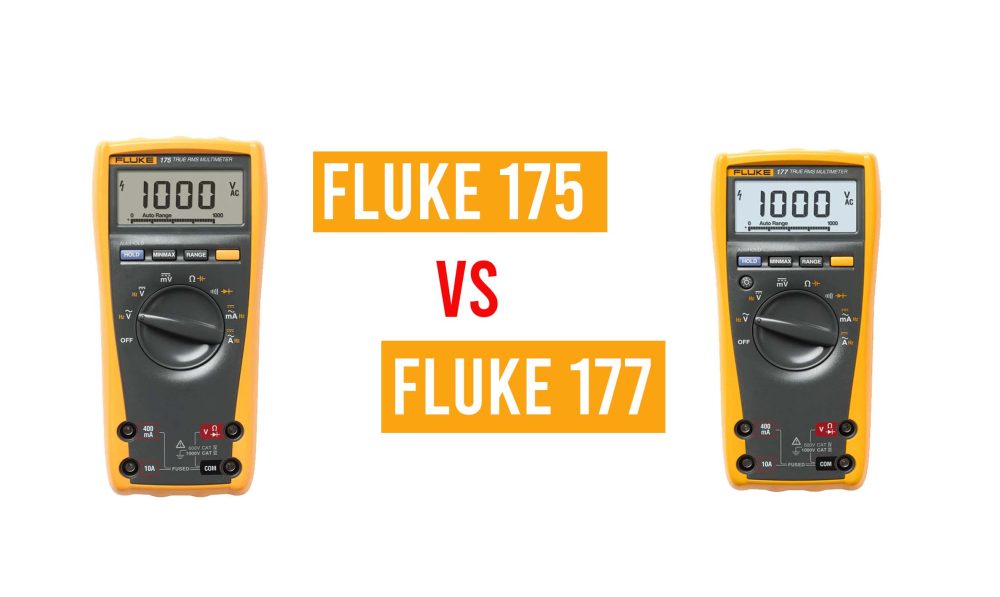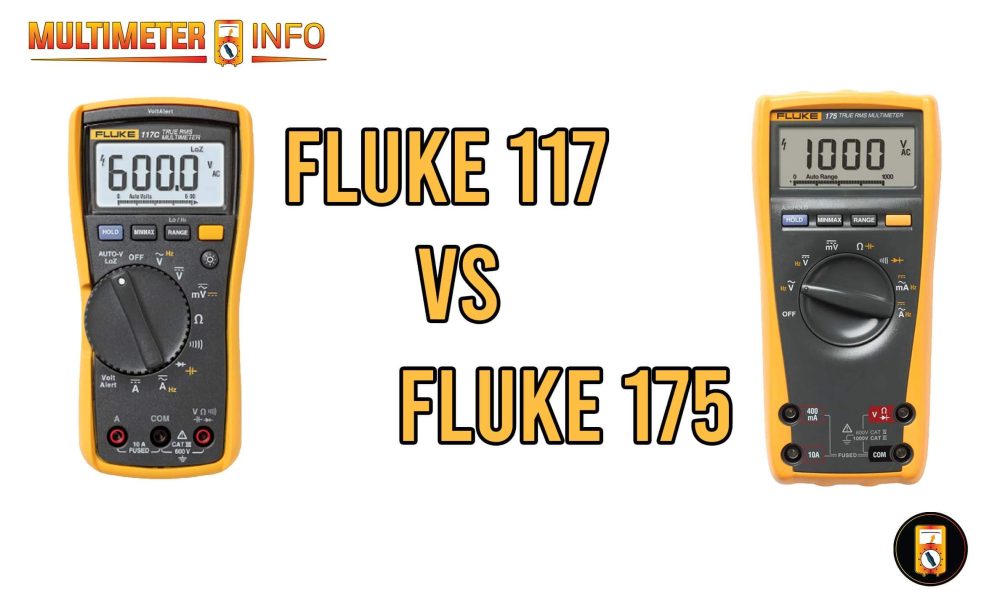Do you have to choose between Fluke 287 and Fluke 289 for your multimeter requirements? You are not by yourself. Finding a suitable digital multimeter can be difficult because there are many brands and models to choose from, each with its advantages. If you’ve narrowed it down to two of the best multimeters on the market – Fluke’s 287 and 289 – this post is for you. With a detailed comparison of both options, this review will delve into their distinct specifications and features to provide insight into what distinguishes each model, allowing you to make an informed decision when choosing the right one.

What’s in the box:

What’s in the box:
Comparison Table Fluke 287 VS 289
Features
Fluke 287
Fluke 289
Logging memory
Up to 10,000 readings
Up to 15,000 readings
True RMS
Yes
Yes
Measurement Accuracy
+/-0.5%
+/-0.5%
Weight
870.9 g
870.9 g
Warranty
Lifetime
Lifetime
Difference Between Fluke 287 VS 289:
The main difference between the Fluke 287 and 289 models is that the Fluke 289 model has additional data logging capabilities. This means that it will automatically store readings over time and allow you to review them later on. It also has built-in TrendCapture™ technology, which allows users to quickly analyze trends in their measurements with relative ease.
Logging Memory:
The Fluke 287 True-RMS Electronics Logging Multimeter has a logging memory of up to 10,000 readings. The Fluke 289 True-RMS Industrial Logging Multimeter has a logging memory of up to 15,000 readings.
Fluke Connect:
The Fluke 287 and 289 Multimeters are compatible with the Fluke Connect mobile app and Fluke Connect-enabled test tools with an optional connector.
dB & Conductance Measurements:
Yes, both multimeters have dB and conductance measurement capabilities.
Motor Drive (ASD) Measurements:
Only the Fluke 289 True-RMS Industrial Logging Multimeter has motor drive (ASD) measurement capabilities.
LoZ: Low Input Impedance:
Fluke 289 has only had the low input impedance (LoZ) feature, while Fluke 287 does not.
Lo Ohms:
The Fluke 289 has a Lo Ohms feature, whereas the Fluke 287 does not have this capability.
MIN/MAX/AVG captures:
Fluke 287 and 289 both offer MIN/MAX/AVG capture capabilities for data logging and graphing functions.
TrendCapture:
The Fluke 287 has a TrendCapture feature which is not available in the Fluke 289 Multimeter. This allows users to graphically review logged readings onscreen without having to download or print data after completing a measurement session.
Fluke 287 True-RMS Electronics Logging Multimeter:

Fluke’s 287 True-RMS Electronics Logging Multimeter gives you the power to capture and store data like never before. With its large 50,000 counts ¼ VGA dot matrix display with white backlight, you’ll get sharp and clear images for easy viewing. Plus, you can graphically review up to 10,000 recorded events with onboard TrendCapture. Now it’s easier than ever to stay on top of readings and diagnose problems quickly.
To further increase productivity, use the Fluke Connect mobile app and enabled test tools (with optional connector) to share readings with your team in real-time. You’ll also have the unprecedented ability to zoom up to fourteen times – without a PC – for more detailed data analysis. The Fluke 287 True-RMS Electronics Logging Multimeter is the ultimate tool for any serious electronics technician. Get reliable readings and store data with more accuracy than ever before.
Features of Fluke 287:
Zoom on Trend:
The Fluke 287 Multimeter features an impressive Zoom on Trend feature that allows users to view and analyze TrendCapture data up to 14 times the original size. This is particularly useful when viewing detailed readings or observing minute changes over time.
AC Filter (Smoothing Mode):
The Fluke 287 Multimeter has a selectable AC filter (smoothing mode) which helps display steadier readings even in cases where the input signal is rapidly changing or noisy. This makes it easier to observe trends in real-time and take accurate measurements.
Adjustable Recording and Auto Hold Thresholds:
Users can adjust the recording and auto-hold thresholds to specify a percentage change in the readings that begins a new event. This makes it easier to keep track of changes and measurements over time and make more accurate observations from the data.
Large 50,000 Count Display:
The Fluke 287 Multimeter has a large 50,000 count 1/4 VGA display with a white backlight for easy viewing even in dimly lit environments. The large size also allows multiple sets of measurement information to be displayed simultaneously.
Logging Function:
The Fluke 287 Multimeter has an expanded memory for logging signals over time and performing unattended monitoring tasks efficiently. It stores up to 15 logs, each with 10,000 recorded readings, making it an ideal tool for complex measurement tasks.
Relative Mode:
The Fluke 287 Multimeter has a handy relative mode that allows users to remove offset errors from the measurements and view only the changes in voltage or other values being measured. This is particularly useful when observing a signal over a long period.
Min/Max Recording:
For recording min/max signals accurately without compromising accuracy, the Fluke 287 Multimeter has an advanced min/max recording feature. It records all the maximum and minimum measurements for easy recall later or for further analysis.
Auto-Off Function:
The Fluke 287 Multimeter also features an auto-off function which automatically turns the device off after a specified amount of time if it is not being used, conserving battery life and saving energy.
Low Battery Indicator:
Lastly, the Fluke 287 Multimeter has a low battery indicator that lets users know when the device’s batteries are running low on power so they can be replaced before any readings become unreliable due to low voltage levels. This ensures that accurate measurements are always taken with the Fluke 287 Multimeter.
FAQS Fluke 287 Digital Multimeter:
The Fluke 287 Digital Multimeter weighs 870.9 g (28 oz).
Yes, the Fluke 287 Digital Multimeter has multiple onscreen displays.
Yes, the Fluke 287 Digital Multimeter has a True RMS AC bandwidth of 100 kHz.
Yes, the Fluke 287 Digital Multimeter can measure dBV/dBm.
The DC mV resolution of the Fluke 287 Digital Multimeter is 1 μV.
The Fluke 287 Digital Multimeter can measure up to 500 MΩ.
Yes, the Fluke 287 Digital Multimeter has a conductance measurement with a 50.00 nS range.
Yes, the Fluke 287 Digital Multimeter has a continuity beeper feature included in its design.
Yes, the Fluke 287 Digital Multimeter has both battery and fuse access.
Yes, the Fluke 287 Digital Multimeter has optional wireless connectivity capabilities.
Fluke 289 True-RMS Stand-Alone Logging Multimeter

The Fluke 289 logging multimeter is the ultimate troubleshooting and analysis tool for electronics, plant automation, power distribution, and electro-mechanical equipment. Its unique set of functions provides users numerous benefits over traditional digital multimeters. It has a low impedance voltage function to eliminate ghost voltages, a low pass filter for precise voltage and frequency measurements, a two-terminal 50ohm range with 1 milliohm resolution and 10 mA source current, true-RMS AC voltage and current for exact measurements on non-linear signals, a measurement capability of up to 10 A (20 A for 30 seconds), a 100 mF capacitance range, and peak capture to record transients as fast as 250 seconds.
Fluke 289 also has premium test leads and alligator clips for improved accuracy and performance. With the Fluke 289’s advanced features, users can quickly troubleshoot and analyze problems that would be difficult to identify with a traditional digital multimeter. The range of measurements, logging capabilities, and results analysis make it a powerful tool in any technician’s arsenal.
Features of Fluke 289 Multimeter:
ShareLive™:
Share your results with your team via a video call with the help of an ir3000 FC wireless connector (sold separately) and the Fluke Connect mobile app – all for free!
TrendCapture:
Graphically display logged data sessions to identify anomalies in readings easily.
Zoom on trend:
Increase detail 14 times over to examine readings in unprecedented clarity.
AC Filter:
Manage rapid or noisy input signals more effectively by selecting between smoothing modes.
Low Pass filter:
Accurately measure frequency and voltage simultaneously, even in adjustable speed motors.
Measurements Over Time:
Record up to 15 000 points of data at intervals from 1 second to 24 hours.
Min/Max/Average:
Monitor a signal’s peak, lowest and average values in real time.
True RMS:
Enjoy precise AC voltage and current measurements even on non-linear signals with True RMS technology.
Inrush:
Measure motor start-up current accurately with the unique Inrush measurement feature.
VOLTalert™:
Stay safe with an audible warning when dangerous voltages are detected – no need for direct contact!
FAQS About Fluke 289 Multimeter:
The maximum voltage between any terminal and earth ground is 1000V.
The Fluke 289 Multimeter uses 6 AA alkaline batteries, IECLR6.
The battery life lasts for a minimum of 100 and 200 hours in logging mode.
The operating temperature range is -20°C to 55°C while the storage temperature range is -40°C to 60°C.
The relative humidity range is 0 to 90% (0 to 37°C), 0 to 65% (37°C to 45°C), and 0 to 45% (45°C to 55°C).
Yes, it does comply with EMC EN61326–1.
The Fluke 289 Multimeter has undergone random vibration per MIL-PRF-28800F Class 2 Testing.
The Fluke 289 Multimeter has undergone a 1-meter drop per IEC/EN 61010–1 3rd Edition Testing.
The dimensions for this multimeter are 22.2 x 10.2 x 6 cm (8.75 x 4.03 x 2.38 in), and it weighs 870.9 g (28 oz).
Yes, the Fluke 289 Multimeter has multiple onscreen displays and a True-RMS AC bandwidth of 100.
Conclusion:
In Conclusion, the Fluke 287 True-RMS Electronics Logging Multimeter and the Fluke 289 TRMS Industrial Logging Multimeter with TrendCapture are two of the most accurate, dependable tools on the market. Both offer outstanding value and reliability, making them ideal for professionals and amateurs. When it comes down to choosing between the two models, it is essential to consider your specific needs and budget. The Fluke 287 offers a wide range of features at an affordable price point, while the Fluke 289 provides more advanced logging capabilities and calibration options. Ultimately, either choice would be a wise investment to help you stay up-to-date with today’s electrical applications.





